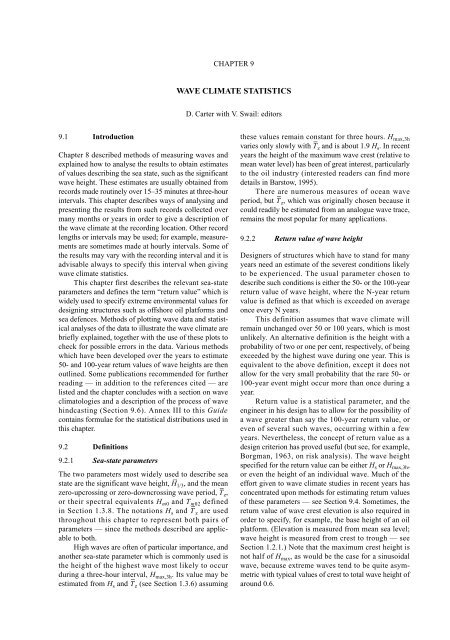GUIDE WAVE ANALYSIS AND FORECASTING - WMO
GUIDE WAVE ANALYSIS AND FORECASTING - WMO
GUIDE WAVE ANALYSIS AND FORECASTING - WMO
Create successful ePaper yourself
Turn your PDF publications into a flip-book with our unique Google optimized e-Paper software.
9.1 Introduction<br />
Chapter 8 described methods of measuring waves and<br />
explained how to analyse the results to obtain estimates<br />
of values describing the sea state, such as the significant<br />
wave height. These estimates are usually obtained from<br />
records made routinely over 15–35 minutes at three-hour<br />
intervals. This chapter describes ways of analysing and<br />
presenting the results from such records collected over<br />
many months or years in order to give a description of<br />
the wave climate at the recording location. Other record<br />
lengths or intervals may be used; for example, measurements<br />
are sometimes made at hourly intervals. Some of<br />
the results may vary with the recording interval and it is<br />
advisable always to specify this interval when giving<br />
wave climate statistics.<br />
This chapter first describes the relevant sea-state<br />
parameters and defines the term “return value” which is<br />
widely used to specify extreme environmental values for<br />
designing structures such as offshore oil platforms and<br />
sea defences. Methods of plotting wave data and statistical<br />
analyses of the data to illustrate the wave climate are<br />
briefly explained, together with the use of these plots to<br />
check for possible errors in the data. Various methods<br />
which have been developed over the years to estimate<br />
50- and 100-year return values of wave heights are then<br />
outlined. Some publications recommended for further<br />
reading — in addition to the references cited — are<br />
listed and the chapter concludes with a section on wave<br />
climatologies and a description of the process of wave<br />
hindcasting (Section 9.6). Annex III to this Guide<br />
contains formulae for the statistical distributions used in<br />
this chapter.<br />
9.2 Definitions<br />
9.2.1 Sea-state parameters<br />
The two parameters most widely used to describe sea<br />
state are the significant wave height, – H1/3, and the mean<br />
zero-upcrossing or zero-downcrossing wave period, T – z,<br />
or their spectral equivalents Hm0 and Tm02 defined<br />
in Section 1.3.8. The notations Hs and T – z are used<br />
throughout this chapter to represent both pairs of<br />
parameters — since the methods described are applicable<br />
to both.<br />
High waves are often of particular importance, and<br />
another sea-state parameter which is commonly used is<br />
the height of the highest wave most likely to occur<br />
during a three-hour interval, Hmax,3h. Its value may be<br />
estimated from Hs and T – z (see Section 1.3.6) assuming<br />
CHAPTER 9<br />
<strong>WAVE</strong> CLIMATE STATISTICS<br />
D. Carter with V. Swail: editors<br />
these values remain constant for three hours. H max,3h<br />
varies only slowly with T – z and is about 1.9 H s. In recent<br />
years the height of the maximum wave crest (relative to<br />
mean water level) has been of great interest, particularly<br />
to the oil industry (interested readers can find more<br />
details in Barstow, 1995).<br />
There are numerous measures of ocean wave<br />
period, but T – z, which was originally chosen because it<br />
could readily be estimated from an analogue wave trace,<br />
remains the most popular for many applications.<br />
9.2.2 Return value of wave height<br />
Designers of structures which have to stand for many<br />
years need an estimate of the severest conditions likely<br />
to be experienced. The usual parameter chosen to<br />
describe such conditions is either the 50- or the 100-year<br />
return value of wave height, where the N-year return<br />
value is defined as that which is exceeded on average<br />
once every N years.<br />
This definition assumes that wave climate will<br />
remain unchanged over 50 or 100 years, which is most<br />
unlikely. An alternative definition is the height with a<br />
probability of two or one per cent, respectively, of being<br />
exceeded by the highest wave during one year. This is<br />
equivalent to the above definition, except it does not<br />
allow for the very small probability that the rare 50- or<br />
100-year event might occur more than once during a<br />
year.<br />
Return value is a statistical parameter, and the<br />
engineer in his design has to allow for the possibility of<br />
a wave greater than say the 100-year return value, or<br />
even of several such waves, occurring within a few<br />
years. Nevertheless, the concept of return value as a<br />
design criterion has proved useful (but see, for example,<br />
Borgman, 1963, on risk analysis). The wave height<br />
specified for the return value can be either H s or H max,3h,<br />
or even the height of an individual wave. Much of the<br />
effort given to wave climate studies in recent years has<br />
concentrated upon methods for estimating return values<br />
of these parameters — see Section 9.4. Sometimes, the<br />
return value of wave crest elevation is also required in<br />
order to specify, for example, the base height of an oil<br />
platform. (Elevation is measured from mean sea level;<br />
wave height is measured from crest to trough — see<br />
Section 1.2.1.) Note that the maximum crest height is<br />
not half of H max, as would be the case for a sinusoidal<br />
wave, because extreme waves tend to be quite asymmetric<br />
with typical values of crest to total wave height of<br />
around 0.6.

















